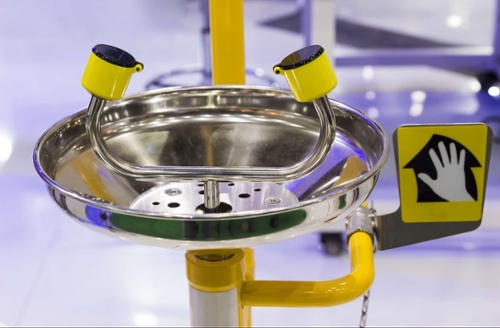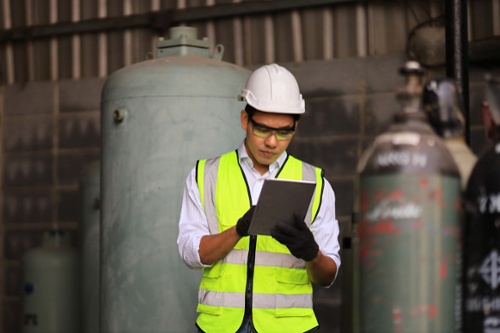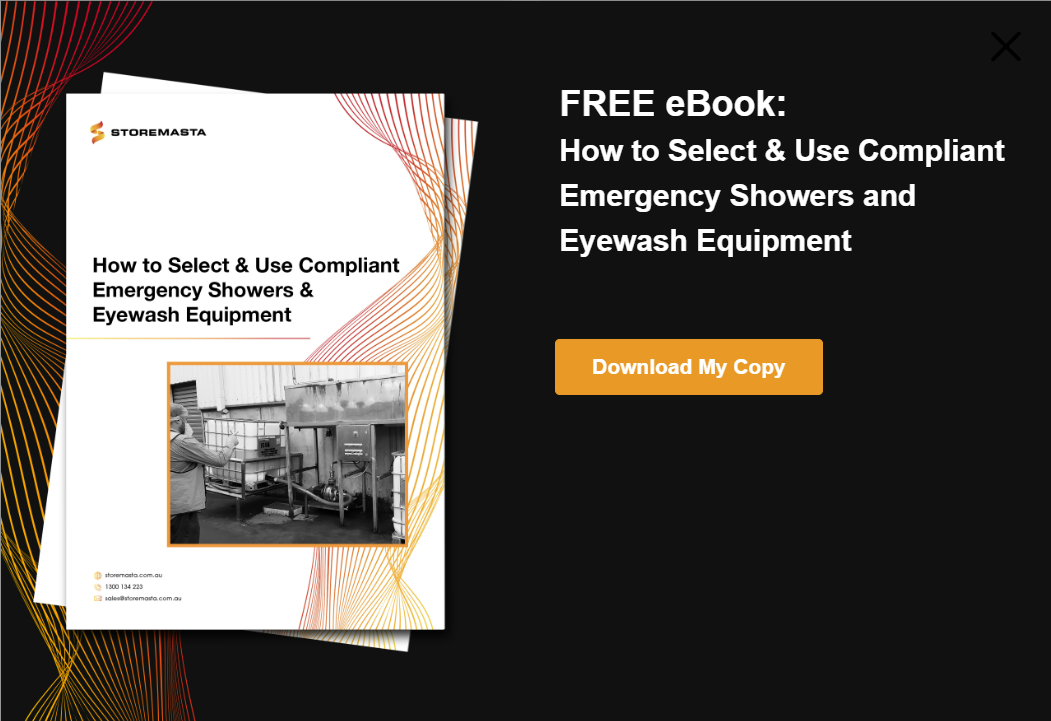Eye injuries in the workplace are very common occurrences. Damage can be from chemical exposure or when foreign objects, such as glass enter the eye area. Eye injuries can be very dangerous — particularly when they involve hazardous chemicals. These injuries can result in progressive tissue damage, permanent blindness, or even death. To protect your staff from incidents of eye injury, we’ll be outlining a 3-step process for determining if your workplace needs an eyewash station. We’ll also be discussing where your emergency decontamination facilities should be installed.
REMEMBER: This is a basic introduction only and we recommend downloading our free guide on how to select and use compliant emergency showers and eyewash equipment.
How Does Eyewash Work?
An eye wash station is a piece of emergency decontamination equipment that is used to minimise the impact of eye damage. The eyewash works by sending a stream of water into both eyes, so any chemicals or foreign objects can be flushed out.
When using an eyewash station, you should flush the eye area for a minimum of 15 minutes to ensure that the hazardous chemicals or materials are effectively removed from the eye area. Purpose-built eye wash stations are specifically designed for emergency decontamination purposes and may feature single action hand or foot levers, with wall, bench, counter and floor-mounted emergency eyewash station options.

Emergency eyewash facilities deliver flushing fluid to both eyes simultaneously, to reduce the harm associated with hazardous chemicals and foreign objects in the eye area.
When is an Eyewash Station Required?
When do you need an eyewash station? There are multiple factors to consider, including the WHS law in your state or territory, the Australian Standards that pertain to your dangerous goods classes, and the hazards that are identified in your onsite risk assessment.
In the next section of our post, we’ll be running you through how you can conduct a risk assessment to find out if you need an eyewash station at your worksite.
IMPORTANT: Safety showers and eyewash stations are not interchangeable facilities. Compliant eyewash stations deliver flushing water at a lower pressure (to both eyes simultaneously) and won’t cause damage to the soft tissue in the eye area.
Step 1: Conduct A Risk Assessment
The first step in determining if you need emergency eyewash equipment is to conduct a risk assessment.
A risk assessment will identify and assesses the chemical hazards or work processes that could expose a worker’s eyes to hazardous materials.
As an example, your hazard identification chart could look something like this:
| Area | Possible source of Hazard | How could eyes be exposed? |
|---|---|---|
|
Containers of unleaded petrol and 2-stroke oil for the garden maintenance equipment (mower, hedge trimmer, brush cutter). |
Eyes splashed when refuelling, scratching or rubbing eyes with contaminated hands/PPE, tripping over when carrying fuel, equipment malfunction. |
|
|
Laboratory |
Hydrochloric Acid used in laboratory experiments. |
Splashing, scratching or rubbing eyes with contaminated hands/PPE, uncontrolled chemical reaction, equipment malfunction. |
PLEASE NOTE: These are simple examples for demonstrating a process and are not intended as specific risk controls.
Once you’ve identified the hazards, you will then need to assess the severity of each hazard and what control measures could be put in place to bring the risk to your workers to an acceptable level. One of the mistakes made by many workplaces is immediately assuming that an eyewash station is a hazard control measure, when it’s actually a piece of first aid equipment.
An emergency eyewash or combination unit will not defend work areas against flying particles or chemical spills. It will not eliminate any risks and dangers at the job site.
Therefore, if workers are exposed to hazardous materials, you should always have other risk control measures in place like isolation devices and personal protective equipment (PPE).
Step 2: Consider Elimination Control Measures
Your risk assessment will always start with trying to determine the ways in which you can eliminate a workplace hazard.
However, if this can’t be achieved, you’ll then look at the ways in which you can minimise the risks to an acceptable level.
Let’s revisit the generic examples that we introduced in Step 1.
| Hazard | Elimination controls | Eyewash station |
|---|---|---|
|
Unleaded petrol and oil reaching the eyes of workers |
Yes. Replace the mower, brush cutter and hedge trimmer with electric models. |
Not required. Decommission flammable liquids store and remove petrol powered equipment from site. |
|
Highly corrosive acid in the eyes. |
No. The lab tests are essential to commercial operations and no chemical substitutes are available. |
Required. Install a bench-mounted unit adjacent to the lab testing station. |
You can see in the two examples above, that there was a way to eliminate the first hazard — which removes the need for an eyewash unit.
But real-life situations are never as simple as this. Perhaps the chemicals (and quantities) may not have required an eyewash station in the first place. Remember our focus here is on having hazard elimination at the centre of your WHS efforts, and to conduct a risk assessment before rushing out and buying equipment.

Determine if you can first eliminate the hazard in your workplace before you consider the selection of emergency eyewash facilities.
Step 3: Select and Install Equipment
Once you’ve identified the areas in your workplace that require emergency eyewash facilities, you’ll need to select a unit that best serves the staff in each area.
Here are some essential considerations:
- Type of eyewash unit - what type of eyewash unit will best suit the area? You might choose a freestanding eyewash station, which is ideal for an outdoor installation; a counter-mounted unit that sits over a sink; a bench mounted emergency eyewash which is suited to labs and other work areas that need an eyewash close to the hazard; or a combination unit that incorporates both a safety shower and an eyewash.
- Location of eyewash - workers must be able to access eyewash stations within 10 seconds of injury, so install the unit on the same level as the hazard. You’ll need to make sure there is a clear path between the work area and the emergency eyewash. According to Australian Safety Standards the eyewash station must be highly visible and have compliant warning placards. The entire area must be well lit.
- Supplementary equipment - if there is any possibility of a collapsed worker requiring decontamination you may need to consider hand-held units and other face-wash equipment to supplement your eyewash stations.
Need an Eyewash Station?
If you need eyewash stations or a safety shower, we suggest downloading our free eBook. Our definitive guide will help you select, use and maintain your eyewash station and shower equipment, so you can reduce the risks posed by exposure to hazardous chemicals and materials in the workplace.
And if you have any further queries about emergency decontamination equipment, such as showers and eyewash stations, reach out to our Dangerous Goods Storage Specialists who can assist with your enquiries.
Joining the team as a Dangerous Goods Storage Consultant, Melissa Hampton became Storemasta's Marketing Manager in late 2021. With extensive knowledge and experience in chemical compliance, Melissa is responsible for leading the Marketing team and helping shape their marketing strategy. In her spare time, you can find Melissa hiking, swimming and enjoying the great outdoors in beautiful north-west Tasmania.
